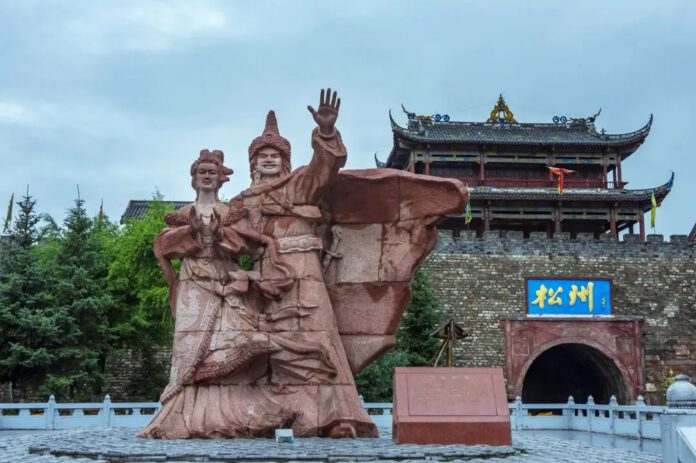
Tibetan Buddhism is a Buddhist tradition with distinct Tibetan characteristics that emerged and developed in the Snowland. Yet it has never been an exclusive belief of the Tibetan people alone. Rather, it has long been a shared faith among numerous ethnic groups within the Chinese nation, including Tibetans, the Tanguts of Western Xia, Han Chinese, Mongols, Manchus, and historically the Uyghurs.
Throughout ancient Chinese history, Tibetan Buddhism served as the dominant religion under multiple dynasties, including the Western Xia, Yuan, Ming, and Qing. Its dissemination and flourishing among these diverse ethnic groups not only reflected but also strengthened the political and cultural unity of the Chinese state, profoundly reshaping the religious and ethnic landscape of ancient China.
Nearly two decades ago, the concept of “Han-Tibetan Buddhism” was proposed as a corrective to the long-dominant Western academic notion of “Indian-Tibetan Buddhism.” This framework emphasizes the historical emergence and development of Tibetan Buddhism from a Han-Tibetan perspective, highlighting its deep connections with Han Chinese Buddhism. In truth, Tibetan Buddhism represents not merely the localization of Buddhism in Tibet, but also a monumental achievement in the broader process of the Sinicization of Buddhism.
The early propagation of Tibetan Buddhism was closely intertwined with the introduction of Chinese Buddhism and its absorption of Han culture. Many of the Buddhist scriptures translated during the Tibetan Empire were derived from Chinese Buddhist texts. The great translator Chos grub (c. 755–849) was fluent in Chinese, Tibetan, and Sanskrit, and his achievements in translation rivaled those of the great translators of Chinese Buddhism, such as Kumarajiva (343–413) and Xuanzang (602–664).
One of the most significant events of the early propagation period was the Samye Debate (792–794) between the Indian gradualist master Padmasambhava and the Chinese Chan monk Moheyan. This debate represented a confrontation between the Chinese doctrine of “sudden enlightenment” and the Indian “gradual enlightenment” tradition. Although later Buddhist historians reinterpreted this event as a symbolic “memory field” in Tibetan Buddhist history, demonizing the “monk’s teachings” as heresy, it in fact reflected the vibrant presence of Chinese Chan Buddhism in early Tibet. The “monk’s teachings,” like the legendary boot left behind by Mahayana upon departing Tibet, never entirely disappeared. Their influence, possibly connected to later Tibetan doctrines such as the Great Perfection (Dzogchen), Mahamudra, and the “Other-Emptiness” philosophy, deserves continued scholarly attention.
Tibetan Buddhism turned eastward at an early stage, embarking on a long process of Sinicization. From the mid-eighth to the mid-ninth century, when the Tibetan Empire ruled the Western Regions, Tibetan culture centered on Buddhism became deeply intertwined with the civilizations of the Western Regions, initiating a long history of exchange and integration. Dunhuang, in particular, served as a pivotal meeting point for Han-Tibetan cultural interaction. Both Han and Tibetan Buddhist traditions converged there, forming the earliest expressions of Han-Tibetan Buddhism.
Manuscripts unearthed at Dunhuang reveal that Chinese Chan literature was extensively translated into Tibetan, indicating the widespread dissemination of Han Chan Buddhism during the Tibetan Empire. At the same time, numerous Tibetan texts and artworks related to the Old Translation Tantras show that the Nyingma School’s tantric practices were already flourishing in the region by the ninth and tenth centuries. Although the Tibetan Empire’s rule over the Western Regions lasted less than a century, it left a deep and lasting cultural imprint. Tibetan remained a common language in the Khotan region until the twelfth century, and Tibetan Buddhism continued to thrive there. By the time of the Mongol Khanate and the Yuan dynasty, the Uyghurs—profoundly influenced by Tibetan Buddhism—served as crucial intermediaries in religious and cultural exchanges between Tibetan lamas and Mongol rulers.
In the early twelfth century, newly translated tantric teachings of Tibetan Buddhism became the dominant esoteric tradition in Tibet and spread widely throughout the Western Xia dynasty. Research on Tibetan Buddhist texts unearthed at Black Water City reveals that Western Xia Buddhism represents an important chapter in the Later Propagation period of Tibetan Buddhism. Among these texts are both Chinese and Western Xia translations of Milarepa’s (1052–1135) “Tummo Meditation” instructions, suggesting that their dissemination in both Tibet and Western Xia occurred almost simultaneously. Furthermore, the Black Water City manuscripts contain esoteric materials from diverse lineages, including Nyingma, Kadam, Sakya, and Kagyu, showing that Tibetan esotericism flourished in Western Xia nearly as early as in Tibet itself. Western Xia likely elevated Tibetan Buddhism to the level of a state religion, with Tibetan lamas serving as imperial tutors to its kings.
Following the fall of Western Xia, several tribal groups tracing their lineage to its royal house migrated into Tibet. Western Xia thus became deeply embedded in Tibetan historical memory, recognized by later Buddhist historians as a Buddhist kingdom and a vital part of Tibetan Buddhist lineage history.
Tibetan Buddhism spread even more extensively under the Mongol Khanate and the Yuan dynasty. Beginning with the alliance between the Mongol prince Köden and the Sakya Pandita uncle-nephew duo in Liangzhou, Tibetan Buddhism became the faith of the Mongols and profoundly transformed their spiritual world. It achieved its widest dissemination across the vast territories of the Mongol Empire. Numerous ethnic groups within the Yuan realm—including Han Chinese, Tanguts, and Uyghurs—embraced Tibetan Buddhism in significant numbers. Under Yuan rule, generations of Sakya lamas served as Imperial Preceptors to the emperors, presiding over the Bureau of Buddhist and Tibetan Affairs and overseeing Buddhist activity across the empire.
During this period, Tibetan masters of various schools—Sakya, Nyingma, and Kagyu—traveled to the Central Plains to teach. The Yuan capital Dadu (modern Beijing) became a major center of Tibetan Buddhism, with esoteric practices flourishing within and beyond the imperial court. Tibetan Buddhist texts were translated into Chinese, Mongolian, Uyghur, and other languages. Among the Uyghur manuscripts discovered in Turpan, a significant portion consists of Tibetan esoteric literature, showing that before their conversion to Islam in the late Yuan period, the Uyghurs were largely adherents of Tibetan Buddhism. Though the Yuan dynasty lasted less than a century, it left a profound political and cultural legacy: the close religious ties between Tibetan lamas, imperial rulers, and the populace helped sustain Tibet’s vassal relationship with successive Chinese central governments.
From the Yuan onward, Mongol devotion to Tibetan Buddhism reshaped the political and religious landscape of northern and northwestern China. The Mongols played a pivotal role in Tibet’s religious history: from Sakya Pandita and Kublai Khan to the Third Dalai Lama and Altan Khan, and later the Fifth Dalai Lama and Gushri Khan, they established enduring patron-priest relationships that embodied the fusion of politics and religion between Mongolia and Tibet. The Qianlong Emperor of the Qing dynasty explicitly stated that the Qing promotion of the Yellow Sect aimed to pacify the Mongols, affirming that Tibetan Buddhism had long served as a bridge uniting the Mongol and Tibetan peoples.
Under the unprecedented unification of the Mongol Khanate and Yuan Empire, Tibetan Buddhism spread widely among Han, Tibetan, and Mongol populations, as well as throughout Western Xia and the Western Regions, marking a glorious chapter in its Sinicization. The Mongols’ rapid adoption of Tibetan Buddhism had deep roots in the Western Xia legacy, while its flourishing during the Yuan dynasty laid the foundation for its broader acceptance in the Ming and Qing periods. From Western Xia through the Yuan, Ming, and Qing dynasties, Tibetan Buddhism became a shared faith among multiple ethnic groups and a crucial spiritual bond linking these successive dynasties.
Following the fall of the Yuan, the Ming emperors continued and even deepened imperial support for Tibetan Buddhism. The Yongle Emperor, shortly after ascending the throne, invited the Fifth Karmapa to the capital and hosted a grand Buddhist assembly at Linggu Temple in Nanjing attended by over twenty thousand monks to pray for the souls of his parents, the founding emperor and empress of the Ming dynasty. The Yongle Emperor also invited eminent Tibetan masters from Ü-Tsang, conferring upon them the titles of “Three Great Dharma Kings” and “Five Great Dharma Kings,” and allowed over two thousand Tibetan monks to reside permanently in the capital to serve the imperial court.
Throughout the Ming dynasty, Beijing became a major center for Tibetan Buddhism. The Tibetan Scripture Workshop in the city produced numerous translations, while the western suburbs housed large monasteries accommodating thousands of Tibetan monks. Nearly all major monasteries in Ü-Tsang maintained tribute relations with the Ming court. Most surviving Chinese translations of Tibetan esoteric texts date from the early Ming period, and the number of Han Chinese practitioners of Tibetan Buddhism far exceeded that of the Yuan era. Many high-ranking Ming court monks, bearing titles such as “National Preceptor” and “Dharma King,” were Tibetan lamas. Tibetan Buddhism thus achieved a remarkable level of Sinicization during the Ming dynasty, surpassing Han Buddhism in imperial prestige and influence.
The Qing rulers, like their Ming predecessors, actively supported Tibetan Buddhism, which became the dominant Buddhist tradition of the Qing era. Emperors Shunzhi, Kangxi, Yongzheng, and Qianlong all demonstrated sincere devotion to it. Although Emperor Qianlong often claimed his promotion of the Yellow Sect served political goals—chiefly to stabilize the Mongols—his personal faith was evident. He constructed the Fanhualou temple within the imperial palace for his own esoteric practice, collected extensive Tibetan ritual texts, commissioned the translation of the Tibetan Buddhist canon into Manchu, and even designed his mausoleum as a mandala. He also built the Eight Outer Temples around the Rehe Summer Palace, integrating political strategy with religious devotion and creating a permanent center for Tibetan Buddhism in the Chinese heartland.
The Qing dynasty’s state masters, including the Zhangjia Hutuktu and other lamas stationed in Beijing, played key roles in spreading Tibetan Buddhism throughout the empire. Together with the Dalai Lama and Panchen Lama, they served as spiritual leaders of the Qing realm. Tibetan Buddhism continued to flourish, reaching broader audiences among the multi-ethnic population and undergoing further Sinicization. Emperor Qianlong, who regarded himself as a Bodhisattva Emperor, actively shaped its development through policies such as the Golden Urn selection system, which formalized reincarnation recognition and strengthened state oversight of the faith.
Through continuous fusion across the Western Xia, Yuan, Ming, and Qing dynasties, this process produced the distinctive form of Tibetan Buddhism that endures today—a form deeply rooted in Chinese civilization and distinct from its Indian origins. Tibetan Buddhism, therefore, must be understood not merely as a regional adaptation of Buddhism, but as an integral and vital component of Chinese Buddhism itself.
Source: dzh, cpc people, kdl gov, xizang gov



